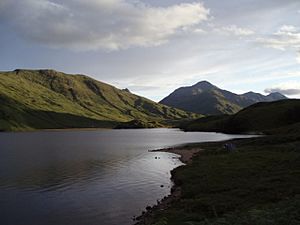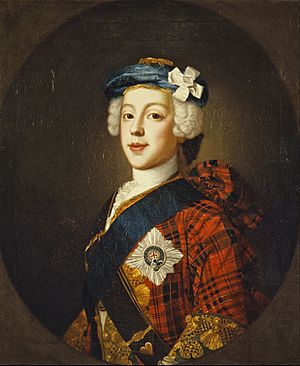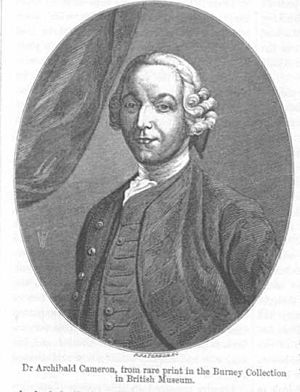Loch Arkaig treasure facts for kids
The treasure of Loch Arkaig, sometimes called the Jacobite gold, was a large amount of gold coins. Spain sent this money to help the Jacobite rebellion in Scotland in 1745. People still say it is hidden at Loch Arkaig in Lochaber.
Contents
Why the Treasure Was Needed

In 1745, Prince Charles Edward Stuart, also known as Bonnie Prince Charlie, came to Scotland from France. He wanted to become king of Scotland, England, and Ireland. He claimed this right for his father, James Stuart.
Charles said that the King of France, Louis XV, supported his plan. He also said that French soldiers would soon arrive in Scotland. But the truth was, France did not really plan to help the Stuarts much. Still, Spain and the Pope did send some money.
Spain promised to send about 400,000 French coins, called livres or Louis d'Or, every month. This money was for the Jacobite side. But getting the money to the rebel army was very difficult.
The first payment was sent in 1745 through Charles's brother, Henry, who lived in France. A small French ship called the Hazard (later renamed the Prince Charles) successfully brought this money to the west coast of Scotland. But soon after, soldiers from Clan Mackay, who supported King George II, captured the money in the Skirmish of Tongue. This was bad news for the Jacobites.
The Treasure Arrives
In April 1746, two ships, the Mars and the Bellona, arrived in Scotland. They carried 1,200,000 French coins. This was another payment from Spain, plus a lot extra from France.
However, the Jacobites lost the Battle of Culloden on April 16. When the ships heard about this defeat, they left. But they did unload the Spanish money at Loch nan Uamh in Arisaig on April 30. This was the same place where Prince Charles had landed the year before, and where he would later leave Scotland for France.
So, seven boxes of Spanish gold arrived in Scotland. By then, the Jacobites had lost the war. Their army was scattered, and the prince and his main helpers were hiding. The money was meant to help the Jacobite clans. They were being treated harshly by the government soldiers of the Duke of Cumberland. The money was also to help leading Jacobites escape to Europe.
Six of the boxes were taken to Loch Arkaig, just north of Fort William, and hidden there. One box had been stolen by some of McDonald of Barrisdale's men. The secret of the hidden gold was given to Murray of Broughton, who was also a Jacobite hiding from the government.
Murray started giving out the money to the clan chiefs. But then the government caught him. He later told them what he knew. So, the treasure was then given to Lochiel, the chief of Clan Cameron. After that, it went to Ewen MacPherson of Cluny, the head of Clan Macpherson. Cluny was hiding in a cave at Ben Alder, which people called "the cage." When Prince Charles briefly joined him there, Cluny was in charge of the money, which was still hidden at Arkaig.
Searching for the Treasure
Prince Charles finally escaped Scotland on a French ship called L'Heureux. He arrived back in France in September 1746. But what happened to the money is not so clear.
People believe Cluny kept control of the gold. During his many years as a fugitive, he was involved in different plans to fund another uprising. He stayed hidden in his Highland "cage" for eight more years. Meanwhile, Charles, who always needed money, kept looking for his share. Some of the gold did reach him later. He used it to pay for a special medal in the 1750s.
However, it is said that not all the gold was ever found. Years later, Charles accused Cluny of keeping some of the money for himself. Whatever happened, the gold caused many arguments and bad feelings among the Jacobites who were still alive.
In 1753, Archibald Cameron, Lochiel's brother, was sent back to Scotland. He was the secretary to Charles's father, the Old Pretender. His job was to find the treasure. But while he was secretly staying near Loch Katrine, someone betrayed him. It seems it was a spy called "Pickle." Archibald was arrested. He was charged for his part in the 1745 uprising and sentenced to death. He was executed on June 7, 1753, at Tyburn. He was the last Jacobite to be executed.
After this, the trail of the treasure becomes unclear. However, the Stuart family's old papers, now owned by Queen Elizabeth II, show many claims and arguments. Highland chiefs and Jacobites living in other countries argued about what happened to the money.
The historian Andrew Lang was one of the first people to study these papers after Walter Scott got them for the crown. In his book Pickle the Spy (1897), Lang wrote about the difficult story. He also wrote about how both Prince Charles and his father tried to find the money. The Stuart papers also include a record from around 1750. It was written in Rome by Archibald Cameron. This record suggests that Cluny could not, or would not, explain what happened to all the money.
According to records from Clan Cameron, some French gold coins were found buried in nearby woods in the 1850s.
In Fiction
The "Arkaig treasure" has appeared in several stories:
- It is in Nigel Tranter's historical novel Gold for Prince Charlie.
- The missing treasure is part of Neil Munro's novel Children of the Tempest. This is a love story set in the Outer Hebrides in the late 1700s. It was first published in 1903.
- The treasure also appears in Diana Gabaldon's Outlander series of historical novels. It is an important part of the story in The Fiery Cross, the fifth book in the series.
- The treasure is featured in the Sherlock Holmes story The Adventure of the Dishonourable Discharge by Craig Janacek. It is in The MX Book of New Sherlock Holmes Stories, Part XII: Some Untold Cases (1894-1902).
See also
 In Spanish: Tesoro de Loch Arkaig para niños
In Spanish: Tesoro de Loch Arkaig para niños



